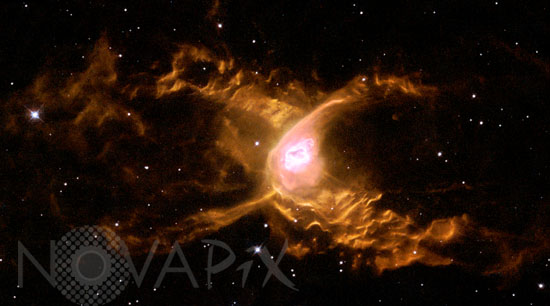Photo Agency - Astronomy - Space - Nature

Planetary nebula NGC 6537
author: ESA/Novapix
reference: a-nep65-37001
Image Size 300 DPI: 27 * 15 cm
Hubble observations have revealed huge waves sculpted in the Red Spider nebula. This warm and windy planetary nebula harbours one of the hottest stars in the Universe and its powerful stellar winds generate waves 100 billion kilometres high. The Red Spider Nebula, NGC 6537, is a striking 'butterfly' or bipolar (two-lobed) planetary nebula. Planetary nebulae are the glowing embers of ordinary stars, such as our Sun. At the end of their lives these stars expel most of their material into space, often forming a two-lobed structure as in the case of the Red Spider. These waves are driven by stellar winds radiating from the hot central star, much as a wind passing over a lake can generate waves on the water. The waves reach peaks 100 billion kilometres high and must have been produced by a powerful wind blowing with a speed of 2000-4500 kilometres per second (about 7-16 million km/hr). The waves themselves move outwards at a slower rate of 300 km/s (about 1 million km/hr). To add to these challenging climatic conditions, this nebula is not only windy, but also hot. The temperature of the gas waves is a scorching 10,000 K Detailed investigations of the Hubble image have shown that the central white dwarf, the remaining compact core of the original star, must have a temperature of at least half a million degrees, making it one of the hottest stars known. It is so hot that it is invisible to Hubble's eye and emits primarily in X-rays. The Red Spider nebula is located about 3000 light-years away in the constellation of Sagittarius.
Contact : Stéphane Aubin +33-(0)9-51-26-53-76
© Novapix - All rights reserved


